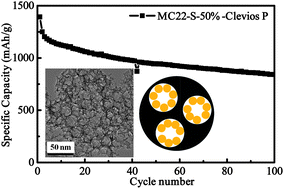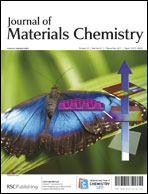Mesoporous carbon (MC) with tunable pore sizes (22 nm, 12 nm, 7 nm, and 3 nm) and pore volumes (from 1.3 to 4.8 cm3 g−1) containing sulfur in the pores was studied as a mesoporous carbon–sulfur (MCS) composite electrode for lithium–sulfur (Li–S) batteries. Systematic investigation of these MCS composites reveals that MC with a larger pore volume can hold a higher maximum sulfur loading, but overall the battery performance is very similar for different MCS composites at full sulfur-filling conditions (i.e., the condition at which the sulfur loading approaches the maximum limit set by the pore volume of the individual MC and, therefore, the pores of each MC are fully filled by sulfur). For the same MC, partial sulfur-filling (i.e., the condition at which the sulfur loading is lower than the maximum limit and, therefore, the pores are only partially filled with sulfur) leads to an improved initial discharge capacity and cycle stability, probably because of improved electrical and ionic transport during electrochemical reactions. Based on this understanding, an MCS composite electrode using MC with a large pore volume, partial sulfur filling, and a novel surface modification was designed for Li–S batteries. An initial capacity of ∼1390 mA h g−1 (based on sulfur) and a capacity retention of ∼840 mA h g−1 over 100 cycles at a 0.1 C rate were obtained using MC (22 nm, 4.8 cm3 g−1) with 50 wt% sulfur loading and a commercially available Clevios P (poly(3,4-ethylenedioxythiophene)poly(styrenesulfonate) (PEDT/PSS)) coating.


 Please wait while we load your content...
Please wait while we load your content...